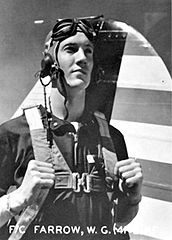

Photograph provided by Darlington County Historical Commission.


Photograph provided by Darlington County Historical Commission.
This photo was retrieved from a collection of unidentified photographs in the Darlington County Historical Commission’s file of unidentified photos.
If you recognize this photo, contact Brian Gandy–Director of the Darlington County Historical Commission.


Photograph provided by Darlington County Historical Commission.
Mayor X and Fire Chief x shake hands as they welcome a new fire engine to the department.


Photograph provided by Darlington County Historical Commission.
A native of Darlington, Farrow was an American hero that participated, was captured, and killed during the Doolittle Raid in 1942. This is one of the only photos of Lieutenant Farrow.


This photo is a work in progress.
This is the current condition of the colorization of this photo; more adjustments are going to be made in the future to more accurately portray the color of the uniform, straps, etc.
Photograph provided by Darlington County Historical Commission.
A rare glimpse of the Darlington Square, taken as a panoramic image, in the 1920s.


Want to view the photos in more detail? Here are the full images:
Black and White Photograph
Black and White Photograph (damage removed)
Colorized Photograph
Photograph provided by Darlington County Historical Commission.
The horizon or skyline is the apparent line that separates earth from sky, the line that divides all visible directions into two categories: those that intersect the Earth’s surface, and those that do not. At many locations, the true horizon is obscured by trees, buildings, mountains, etc., and the resulting intersection of earth and sky is called the visible horizon. When looking at a sea from a shore, the part of the sea closest to the horizon is called the offing. The word horizon derives from the Greek “ὁρίζων κύκλος” horizōn kyklos, “separating circle”,from the verb ὁρίζω horizō, “to divide”, “to separate”, and that from “ὅρος” (oros), “boundary, landmark”.
Historically, the distance to the visible horizon has long been vital to survival and successful navigation, especially at sea, because it determined an observer’s maximum range of vision and thus of communication, with all the obvious consequences for safety and the transmission of information that this range implied. This importance lessened with the development of the radio and the telegraph, but even today, when flying an aircraft under visual flight rules, a technique called attitude flying is used to control the aircraft, where the pilot uses the visual relationship between the aircraft’s nose and the horizon to control the aircraft. A pilot can also retain his or her spatial orientation by referring to the horizon.
In many contexts, especially perspective drawing, the curvature of the Earth is disregarded and the horizon is considered the theoretical line to which points on any horizontal plane converge (when projected onto the picture plane) as their distance from the observer increases. For observers near sea level the difference between this geometrical horizon (which assumes a perfectly flat, infinite ground plane) and the true horizon (which assumes a spherical Earth surface) is imperceptible to the naked eye dubious – discuss but for someone on a 1000-meter hill looking out to sea the true horizon will be about a degree below a horizontal line.
The horizon or skyline is the apparent line that separates earth from sky, the line that divides all visible directions into two categories: those that intersect the Earth’s surface, and those that do not. At many locations, the true horizon is obscured by trees, buildings, mountains, etc., and the resulting intersection of earth and sky is called the visible horizon. When looking at a sea from a shore, the part of the sea closest to the horizon is called the offing. The word horizon derives from the Greek “ὁρίζων κύκλος” horizōn kyklos, “separating circle”,from the verb ὁρίζω horizō, “to divide”, “to separate”, and that from “ὅρος” (oros), “boundary, landmark”.
Historically, the distance to the visible horizon has long been vital to survival and successful navigation, especially at sea, because it determined an observer’s maximum range of vision and thus of communication, with all the obvious consequences for safety and the transmission of information that this range implied. This importance lessened with the development of the radio and the telegraph, but even today, when flying an aircraft under visual flight rules, a technique called attitude flying is used to control the aircraft, where the pilot uses the visual relationship between the aircraft’s nose and the horizon to control the aircraft. A pilot can also retain his or her spatial orientation by referring to the horizon.
In many contexts, especially perspective drawing, the curvature of the Earth is disregarded and the horizon is considered the theoretical line to which points on any horizontal plane converge (when projected onto the picture plane) as their distance from the observer increases. For observers near sea level the difference between this geometrical horizon (which assumes a perfectly flat, infinite ground plane) and the true horizon (which assumes a spherical Earth surface) is imperceptible to the naked eye dubious – discuss but for someone on a 1000-meter hill looking out to sea the true horizon will be about a degree below a horizontal line.
The horizon or skyline is the apparent line that separates earth from sky, the line that divides all visible directions into two categories: those that intersect the Earth’s surface, and those that do not. At many locations, the true horizon is obscured by trees, buildings, mountains, etc., and the resulting intersection of earth and sky is called the visible horizon. When looking at a sea from a shore, the part of the sea closest to the horizon is called the offing. The word horizon derives from the Greek “ὁρίζων κύκλος” horizōn kyklos, “separating circle”,from the verb ὁρίζω horizō, “to divide”, “to separate”, and that from “ὅρος” (oros), “boundary, landmark”.
Historically, the distance to the visible horizon has long been vital to survival and successful navigation, especially at sea, because it determined an observer’s maximum range of vision and thus of communication, with all the obvious consequences for safety and the transmission of information that this range implied. This importance lessened with the development of the radio and the telegraph, but even today, when flying an aircraft under visual flight rules, a technique called attitude flying is used to control the aircraft, where the pilot uses the visual relationship between the aircraft’s nose and the horizon to control the aircraft. A pilot can also retain his or her spatial orientation by referring to the horizon.
In many contexts, especially perspective drawing, the curvature of the Earth is disregarded and the horizon is considered the theoretical line to which points on any horizontal plane converge (when projected onto the picture plane) as their distance from the observer increases. For observers near sea level the difference between this geometrical horizon (which assumes a perfectly flat, infinite ground plane) and the true horizon (which assumes a spherical Earth surface) is imperceptible to the naked eye dubious – discuss but for someone on a 1000-meter hill looking out to sea the true horizon will be about a degree below a horizontal line.
The horizon or skyline is the apparent line that separates earth from sky, the line that divides all visible directions into two categories: those that intersect the Earth’s surface, and those that do not. At many locations, the true horizon is obscured by trees, buildings, mountains, etc., and the resulting intersection of earth and sky is called the visible horizon. When looking at a sea from a shore, the part of the sea closest to the horizon is called the offing. The word horizon derives from the Greek “ὁρίζων κύκλος” horizōn kyklos, “separating circle”,from the verb ὁρίζω horizō, “to divide”, “to separate”, and that from “ὅρος” (oros), “boundary, landmark”.
Historically, the distance to the visible horizon has long been vital to survival and successful navigation, especially at sea, because it determined an observer’s maximum range of vision and thus of communication, with all the obvious consequences for safety and the transmission of information that this range implied. This importance lessened with the development of the radio and the telegraph, but even today, when flying an aircraft under visual flight rules, a technique called attitude flying is used to control the aircraft, where the pilot uses the visual relationship between the aircraft’s nose and the horizon to control the aircraft. A pilot can also retain his or her spatial orientation by referring to the horizon.
In many contexts, especially perspective drawing, the curvature of the Earth is disregarded and the horizon is considered the theoretical line to which points on any horizontal plane converge (when projected onto the picture plane) as their distance from the observer increases. For observers near sea level the difference between this geometrical horizon (which assumes a perfectly flat, infinite ground plane) and the true horizon (which assumes a spherical Earth surface) is imperceptible to the naked eye dubious – discuss but for someone on a 1000-meter hill looking out to sea the true horizon will be about a degree below a horizontal line.
The horizon or skyline is the apparent line that separates earth from sky, the line that divides all visible directions into two categories: those that intersect the Earth’s surface, and those that do not. At many locations, the true horizon is obscured by trees, buildings, mountains, etc., and the resulting intersection of earth and sky is called the visible horizon. When looking at a sea from a shore, the part of the sea closest to the horizon is called the offing. The word horizon derives from the Greek “ὁρίζων κύκλος” horizōn kyklos, “separating circle”,from the verb ὁρίζω horizō, “to divide”, “to separate”, and that from “ὅρος” (oros), “boundary, landmark”.
Historically, the distance to the visible horizon has long been vital to survival and successful navigation, especially at sea, because it determined an observer’s maximum range of vision and thus of communication, with all the obvious consequences for safety and the transmission of information that this range implied. This importance lessened with the development of the radio and the telegraph, but even today, when flying an aircraft under visual flight rules, a technique called attitude flying is used to control the aircraft, where the pilot uses the visual relationship between the aircraft’s nose and the horizon to control the aircraft. A pilot can also retain his or her spatial orientation by referring to the horizon.
In many contexts, especially perspective drawing, the curvature of the Earth is disregarded and the horizon is considered the theoretical line to which points on any horizontal plane converge (when projected onto the picture plane) as their distance from the observer increases. For observers near sea level the difference between this geometrical horizon (which assumes a perfectly flat, infinite ground plane) and the true horizon (which assumes a spherical Earth surface) is imperceptible to the naked eye dubious – discuss but for someone on a 1000-meter hill looking out to sea the true horizon will be about a degree below a horizontal line.